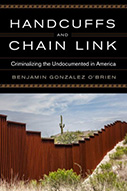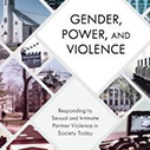Handcuffs and Chain Link: Criminalizing The Undocumented in America

Author: Benjamin Gonzalez O’Brien
Publisher: Charlottesville, VA: University of Virginia Press, 2018. 192p.
Reviewer: Pauline White Meeusen | September 2019
President Trump recently declared a national emergency concerning security on the U.S.-Mexico border as part of his efforts to expand the U.S.-Mexico border wall. Drawing on criminal threat frames, Trump asserted that criminals, gang members, and drugs continue to easily move across the southern border as part of his justification for declaring a national emergency. In this context, Benjamin Gonzalez O’Brien’s book, Handcuffs and Chain Link: Criminalizing the Undocumented in America, which traces the roots and continued linkage between undocumented immigration and undocumented immigrants and criminality, is extremely timely.
Drawing on the idea of path dependence, Gonzalez O’Brien convincingly argues that the Undesirable Aliens Act of 1929 set the pathway for all future policies regarding undocumented immigration by formalizing the association between undocumented immigration and criminality (2, 17). While various racial and ethnic groups had previously been criminalized rhetorically in order to justify segregation, social control, and violence, it was bias against Latinx immigrants, particularly Mexican individuals, he argues, that first led to the cementing of the idea of the criminalization of undocumented immigration into law (18, 52). After the Undesirable Aliens Act was passed, immigrants could be charged with a misdemeanor for an initial entry and a felony for reentering after being deported (4). In laying out this history, Gonzalez O’Brien draws from and builds on historian Mae Ngai and her 2004 book, Impossible Subjects: Illegal Aliens and the Making of Modern America, which eloquently articulated how the increased threat and reality of deportations in the 1920s helped socially construct the idea that a person could be illegal. Unlike Ngai, this author’s focus is on the language used in legislative debates and whether and how this language reflects the criminal threat and other frames.
Gonzalez O’Brien looks at more recent policies and examines how the Immigration Reform and Control Act (IRCA) in 1986 was a break from what had been a continued history of policies that solely utilized social control strategies to combat undocumented immigration. Unlike prior legislation, IRCA combined increased border militarization with sanctions against employers and a broad “amnesty” provision (4). When IRCA did not result in decreased undocumented immigration, Gonzalez O’Brien argues, it became a “critical policy failure,” further supporting criminalization as the sole means of combatting undocumented immigration (4).
Gonzalez O’Brien, however, does not restrict his book to an analysis of formal policy. In the last two chapters of the book, he turns to public opinion and in turn how public opinion shapes the public’s policy preferences. He argues that part of why criminalization has become the predominant means of combatting undocumented immigration is because of a feedback loop, where criminological strategies imbedded in law influence media depictions of undocumented immigrants which in turn influence the public and impact their support of crime control strategies in addressing immigration (3, 107).
Gonzalez O’Brien’s most compelling contribution is his ambitious examination of the positive and negative economic, cultural, and criminal frames in various immigration policies. To support his argument, Gonzalez O’Brien effectively weaves together qualitative and quantitative analyses examining the language in policies over nearly a seventy-five year history. He sets the stage for his argument by examining the language of the Johnson-Reed Act in 1924, which was passed a few years before the Undesirable Aliens Act; this legislation, he argues, reinforced an association between undocumented immigration and criminality. As part of his analysis, he looks at the frequency of mentions of national, regional, and racial identifiers in Senate and House remarks relating to the Johnson-Reed Act and finds that the focus during this period is on Japanese immigration (31). Japanese immigrants are discussed far more than any other nationality, with 525 mentions in the senate and 382 in the House. In contrast, Mexican immigrants are mentioned 107 and 150 times respectively (30-31). He also assesses the use of positive and negative economic, cultural, and criminal frames within individual remarks about the Johnson-Reed Act, including both quantitative counts of statements, numbers of legislators making these references, and qualitative examples of these aspects (34-45). Using similar analyses, he later examines the same aspects in debates leading up to the passage of other legislation including the Undesirable Aliens Act (51-56), IRCA (74-85), and the Illegal Immigration Reform and Immigrant Responsibility Act of 1996 (IIRIRA) (96-106) to see how the use of these aspects shift.
Looking at the language in these policies over time is extremely valuable to contemporary scholarly discussions around “crimmigration” (the intersection between immigration and criminal law) as scholars can examine how the use of these ideas is both constant and dynamic. Through Gonzalez O’Brien’s analysis, we can see how the use of the criminality approach has expanded over time. During the debates around Johnson-Reed there were 11 comments by 3 senators reflecting the criminal threat notion. This grew to 23 comments by 14 senators in debates around IIRIRA (not including use of the word illegal, which was used 467 times in describing undocumented individuals during the legislative debates on IIRIRA) (43, 100-101). At the same time, the criminal threat language becomes more specific and harsher over time, from language that merely describes undocumented immigrants as immigration “lawbreakers” to language that portrays them as “drug dealers and criminals” (101). Moreover, Gonzalez O’Brien demonstrates how the focus of this language has narrowed. Where debates around the Johnson-Reed Act used negative criminal language to describe Japanese, Mexican, and Italian individuals (36, 43), more contemporary debates use the criminal threat frame to describe Latinx immigration, in particularly that from Mexico. This is consistent with other scholarship that has examined stereotypes in media portrayals of immigrants, such as Leo Chavez’s The Latino Threat: Constructing Immigrants, Citizens, and the Nation.
Another contribution of Handcuffs and Chain Link is Gonzalez O’Brien’s fascinating examination of policy preferences among the public. Drawing on the Multi-state Survey of Race and Politics (MSSRP) and the University of Washington Institute for the Study of Ethnicity, Race and Sexuality (WISER) in 2011, he conducts various statistical tests to examine the perceived threats impact on policy preferences among both Black and White respondents. Among his more interesting findings, he discovers that White individuals that believe that crossing the border is a crime, an idea that is factually accurate after the passage of the Undesirable Aliens Act, are more supportive of deportation and less supportive of a pathway to citizenship (145). None of the criminal threat variables, however, had a statistically significant impact on policy preferences among Black respondents (145).
Although his analyses of public perceptions of immigrant criminality and the effects of various frames on policy preferences are thought-provoking, it is unclear why he draws solely from two surveys conducted in 2011 — a very different political moment from 2018, when the book was released. The book would benefit from more contextualization for why these particular surveys were used, rather than say more recent public opinion data. Because immigration policies have changed swiftly over the last several years, and with them potential increased polarization in public opinion and policy preferences, it would have been useful for Gonzalez O’Brien to explicitly articulate why these surveys were used and how they apply in the current moment.
From a broader perspective, the author describes his book as being about criminalizing the undocumented in America; however, it might be more aptly described as the criminalization of Mexican undocumented immigrants. When examining the Undesirable Aliens Act in the 1920s, this singular focus on Mexico makes analytical sense. His argument is that Mexicans are legally constructed as criminals through the Undesirable Aliens Act, as they were mentioned more than three times as often as other nationalities (54). And, he is clear that these laws are part of a racial project: “[t]hese statements regarding Mexicans were not applied to Europeans or Canadians entering illegally across the northern border, though the law applied equally to them. Additionally, . . . comments regarding the immigration of Mexicans . . . reveal the racism that drove much of the desire to limit both legal and illegal Mexican immigration in 1929” (55). But this almost sole focus on Mexican immigrants is less convincing when looking at more contemporary policies and public opinion. For example, Gonzalez O’Brien describes how President Trump called undocumented Mexican immigrants “rapists and criminals” during his presidential campaign (13-14). Trump, as well as others, also applied this same rhetoric to Central American asylum seekers arriving at the U.S. border, framing them in particular media and public discourse as “illegal” immigrants despite legally asserting asylum at the U.S. border or within the interior. More recent public opinion data might focus more on Central American rather than Mexican migrants. Although Gonzalez O’Brien does at times describe the criminalization of Latinx immigrants more broadly and occasionally mentions Central American undocumented immigrants in particular, his primary focus is on Mexican undocumented immigrants. In the present moment, where criminalizing rhetoric is geared to Central Americans to at least the same extent as Mexican individuals, more attention to these individuals would have been useful.
Moreover, in a book about criminalizing the undocumented in America, other undocumented immigrants, such as Asian and Black individuals, are largely absent. It would have been constructive to see more discussion about how the criminal threat idea does not apply to some undocumented immigrants and how others are doubly criminalized through both the immigration and criminal justice systems in the contemporary context. Even if these groups were not specifically mentioned in the more recent legislative debates and public opinion surveys that the author draws from in his analyses, this erasure both among legislators and the public is also important and deserves discussion.
Overall, Handcuffs and Chain Link provides a compelling contribution to several fields including public policy, political science, and migration studies. It is of particular benefit to crimmigration scholars working at the intersection of immigration and criminal law. Written in clear prose and generally lacking jargon, Gonzalez O’Brien’s thoughtful and persuasive book is a beneficial read to individuals both inside and outside of the academy.
Pauline White Meeusen, Ph.D. Candidate, University of California, Berkeley


